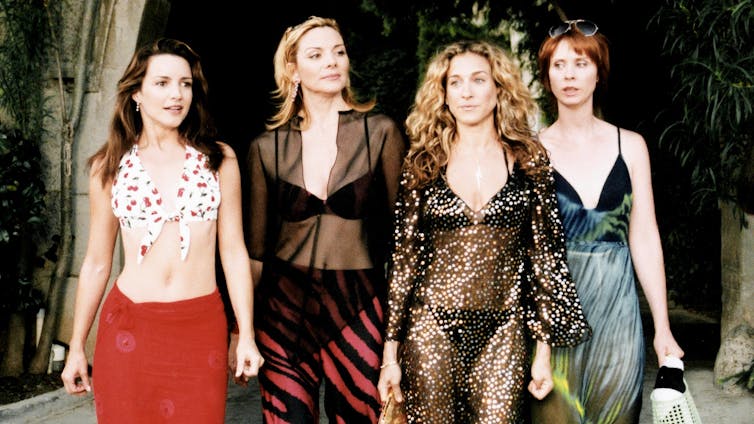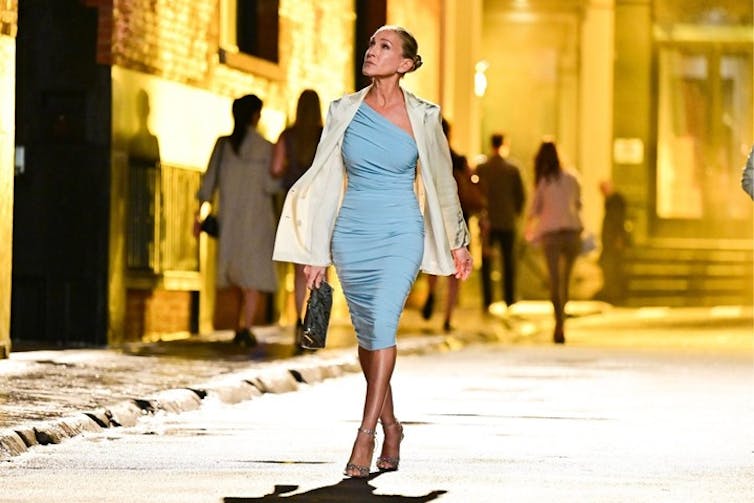Source: The Conversation (Au and NZ) – By Laura Glitsos, Lecturer in Arts and Humanities, Edith Cowan University

The 2020s is the age of the reboot. Without a doubt, one of the most anticipated has been the revival of the iconic TV show Sex and The City, with the 10-episode mini-series And Just Like That.
And Just Like That comes 11 years after the second Sex and the City film, and 17 years after the final season of the HBO television series. The new series picks up where we left off with the characters navigating love and relationships in New York City. In other ways, there is much that has changed as certain characters (spoiler alert) are not present and others are dearly departed. In either case, returning to the Sex and the City world provides a kind of emotional nutrition.
While there might be some sense of nostalgia in the return to Sex and the City it’s only a small, surface part of what drives us back to this show.
To understand why anyone would risk the legacy of Sex and the City with such a perilous return, we need to understand the impact of the original in the first place.

IMDB
Sex and postfeminism
Frank, unapologetic, and female-oriented: Sex and the City was the first of its kind. A television show that took “real” conversations and put them on the screen —warts and all, so to speak.
When Miranda needed advice on her date’s preoccupation with “butt-licking”, the girls were there to talk it out. When Charlotte’s date fell asleep during love-making, the group rallied together for support.
As feminist scholar Jane Gerhard explains, it’s not just the sex that’s exciting–it’s the talking about the sex. In her research, Gerhard writes:
“In season four, when Carrie has a gigantic orgasm with a guy who has an Attention Deficit Disorder, part of the pleasure of that orgasm comes from talking about it to her friends.”

HBO
But its popularity wasn’t just about the sex and its attendant conversations, it was the fact it represented the new incarnation of women’s politics — postfeminism.
Postfeminism is hard to define. At its heart, postfeminism doesn’t do away with feminism – it is a phenomenon in which women’s emergent power sits side-by-side by the contradictions and entanglements of capitalism and patriarchy.
Postfeminism is complicated. Sex is complicated. Yet somehow, Sex and the City took both of these forms and simplified them in witticisms and pithy puns that enabled people of all genders to reflect, question, argue, and best of all, laugh at ourselves. It asked the classic postfeminist questions like, “can women have sex like men?” and it explored how much women must sacrifice for their careers.
Read more:
And Just Like That: how Sex and the City sequel is broadening the representation of 50+ women on TV
Starting the conversation
In many ways, Sex and the City encapsulated late 90s gender politics and contemporary sexual relationships.
Admittedly, the show didn’t always get it “right” and looking back with our current views it may even seem outdated and naïve at times, but what it certainly did do is start the conversation.
The show constantly pushed boundaries. There was of course Carrie’s kiss with Alanis Morrissette in the episode Boy, Girl, Boy Girl, and who could forget Samantha’s affair with the legendary Sônia Braga in season four.
But there were also major flaws. Even at the time, Sex and the City was overtly white-centric and heteronormative. When Samantha announced her lesbian affair it was treated more as a sideshow oddity (especially by Carrie, Charlotte, and Miranda) than a genuine expression of a complex sexual identity.
Unfortunately, with the rebooted And Just Like That, the politics might be updated but the dialogue is far too forced. It’s as if the writers, in their desperate bid to update the show’s politics and erase the naivety of the past, lost the very important art of “show don’t tell”.
Instead of leading us through stories that would highlight the critical changes in our culture around sex, gender, ageing and political sensitivities, And Just Like That gives us clunky, overt, obvious, and frankly weirdly cringe situations that have little if any of the artful craft of screen writing.
Turning to technicolour
Even so, And Just Like That retains some of the original sparkle of its predecessor, intertwining both fashion and friendships as they trend, fade, and sometimes return. For many viewers, watching the first episode of Sex and The City was a bit like watching that moment in The Wizard of Oz when Dorothy opens the cabin door and everything turns to technicolour– complete with the glamour, the glitter and the beautiful shoes.
However, the original show’s fashion was both fabulous and sometimes even accessible to the average viewer. Where once, in the original Sex and the City, there were characters (especially Carrie) who could pull off the most funky outfit from a vintage store, and style it up with just a touch of Balenciaga, in the new And Just Like That, the fashion is so far out of the normal person’s reach that it mocks instead of inspires.
The contrast between the two shows is highlighted by their representations of New York City – often referred to as the “fifth character” of Sex and the City. Sure, its version of Manhattan was always a complete phantasmagoria, but it left in some grittiness. NYC in And Just Like That is instead glossy, super-slick and mostly set in million dollar apartments. What we gained in cleanliness we’ve lost in character.

IMDB
Return to Oz
We wanted — perhaps felt we needed — a return to the fantasy world of Sex and the City. We wanted to “talk things out” once more. The fantasy continues — it’s just no longer matched by the warmth and uniqueness that made us fall in love with it in the first place.
Like returning to Oz, it’s an interesting and sometimes darker journey, but it may not be what you were expecting.
![]()
Laura Glitsos does not work for, consult, own shares in or receive funding from any company or organisation that would benefit from this article, and has disclosed no relevant affiliations beyond their academic appointment.
– ref. Frank, unapologetic, and female-oriented: the cultural legacy of Sex and the City, and the lure of the reboot – https://theconversation.com/frank-unapologetic-and-female-oriented-the-cultural-legacy-of-sex-and-the-city-and-the-lure-of-the-reboot-175061







